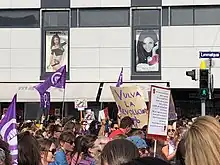2019 Swiss women's strike
Women in the capital of Switzerland and in surrounding communities went on strike in June 2019[1].] Hundreds of thousands of Swiss women went on strike to protest gender inequalities on 14 June 2019. The women's strike, known as Frauenstreik (German) and Grève des Femmes (French) online, consisted of demonstrations in the country's major municipalities for equal pay, recognition of unpaid care work, laws protecting women from harassment sexually and physically, and governmental representation.[1] Women were fighting for equality and respect. Before the strike took place in June 2019, it had been planned for a year.[1] Many women were ready for the opportunity to voice their opinions either for the first time or for a second time after the first strike in 1991. The strike began on 14 June 2019 in the early morning.[2][1] Many women took off work and did not do household responsibilities to show the government their seriousness.[1] These strikes took place in many major communities around Switzerland, including Bern, Zurich, Basel, Geneva, and Lausanne.[2][1] Many protestors gathered around the Federal Assembly in Bern and marched and rallied down the streets.[1] The women on strike wore purple and had signs in purple writing.[1] The color purple is a significant color because it is linked to women's suffrage and gender inequality.[1] In addition, there were many symbols of the strike that women held up and paraded through the streets with. Symbols of the movement included a sculpture of a clitoris and a model of a used tampon.[1] These symbols are intense representations of femininity and are quite powerful when seen as large models that are being held up in the streets. Another symbol was the female sex symbol with a raised fist inside.[2] This is a powerful symbol as it shows women are standing up to fight for their rights. They were not going to back down easily. The strike commenced throughout the day and eventually came to an end at midnight. As the clock struck 12, the Lausanne Cathedral, in Lausanne Switzerland, lit up purple.[1] This was the last sign that showed the people of Switzerland that women deserve better. A quote that fully represents the meaning of the women's strike is, "A paid work strike, a domestic work strike, a care strike, a school strike and a consumer strike".[1]


History
The women's strike that took place in June 2014 was inspired by a previous strike that women organized on 14 June 1991, exactly 28 years before the recent strike.[3] The date of the 2019 Swiss women's strike was set to match the 1991 Swiss women's strike, which was organized 10 years after the acceptance by the Swiss population of the constitutional article on the equality between women and men on 14 June 1981.[4] During this strike, approximately five hundred thousand women participated in one way or another in the movement.[3] After 10 years of demanding a constitutional amendment regarding equal opportunity and treatment for women, they had had enough.[3] Many women took off work, or left work early to join in the strike. Women who did domestic work hung many household cleaning items out of their windows. Items like mops, laundry baskets, drying racks, kitchen tools and other various items in order to show that even women who did work at home were on strike.[3] These women were fighting for better wages, acknowledgement of women who took care of children and did domestic work, and overall respect and equality.[5][2] The motto of the women's strike was, "Wages. Time. Respect".[2] They were tired of not being treated as equal human beings and always being expected to do the domestic duties without getting the recognition that they deserve. Switzerland has been far behind on gender inequality compared to many other European countries.[2] Women did not get the ability to vote at the federal level or to run for office until 1971.[2] In 1985, women were granted the right to open a bank account and to work a job without their spouses permission.[5] According to three articles, women make 18-20% less than men in Switzerland.[5][2][1] This is a significant difference and one that impacts women greatly. According to a study done, women are responsible for 2/3 of tasks in the household.[1] Since childcare is expensive in Switzerland, one partner is expected to stay home and take care of the children while doing the housework.[2] These roles usually fall on women because of unfair gender stereotypes.[1] Women are then not recognized for this work that they do in the house and they also are not receiving any type of funding for this work.
_07.jpg.webp)
 Demonstration in Biel/Bienne, with women holding up signs.
Demonstration in Biel/Bienne, with women holding up signs.
References
- Cumming-Bruce, Nick; Schaverien, Anna (14 June 2019). "Swiss Women Strike Nationwide to Protest Inequalities". The New York Times. ISSN 0362-4331. Retrieved 21 March 2023.
- Kennedt, Merrit (14 June 2019). "'Wages. Time. Respect': Swiss Women Go On Strike". NPR. Retrieved 20 March 2023.
- Gallin, Dan (1 January 1991). "Women's Strike in Switzerland". Agenda. 7 (11): 28–29. doi:10.1080/10130950.1991.9675153. ISSN 1013-0950.
- Abplanalp, Andrej (14 June 2019). "The women's strike day of 1991". Swiss National Museum - Swiss history blog. Retrieved 21 March 2023.
- Henley, Jon; correspondent, Jon Henley Europe (14 June 2019). "Swiss women strike to demand equal pay". The Guardian. ISSN 0261-3077. Retrieved 21 March 2023.
Further reading
- Kirby, Jen (14 June 2019). "Thousands of Swiss women walked out of their jobs to protest inequality". Vox. Retrieved 15 June 2019.
- Pedrero, Agnès (4 June 2019). "Swiss women strike for equal pay again, three decades on". Agence France-Presse. Retrieved 15 June 2019.
- Sakelaris, Nicholas (14 June 2019). "Swiss women strike to protest gender pay gap, inequality". UPI. Retrieved 15 June 2019.
- "Swiss women strike and burn bras in protest against sexism". ABC News. 14 June 2019. Retrieved 15 June 2019.
External links
![]() Media related to the 2019 Swiss women's strike at Wikimedia Commons
Media related to the 2019 Swiss women's strike at Wikimedia Commons